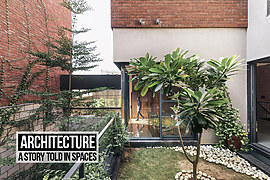If you have been looking up ‘Architectural Journalim’ and the masters options that come with it on the internet, you have probably come across Ar. Apurva Bose Dutta complaining on various platforms about the state of Architectural Journalism in India, Online journalism and writing certificate courses, and a multitude of articles on how Architectural Journalism is a kindred profession.

But what about Masters? Is that even an option?
As of 2020, no university offers a Master of Architecture course in Architectural Journalism. But that doesn’t mean the options stop there. Architectural journalism as a career demands 2 things: good writing skills, and an in-depth knowledge about architecture.
The latter is taken care of by a Bachelor’s degree in Architecture. And here are some Masters courses, available through multiple universities, that provide intensive programs in literature and art/architecture to kick start your Architectural Journalism Career.
1. Master of Arts(MA) in Journalism
Most Journalism programs consider graduates from various backgrounds, depending on the organization. Multiple online courses for the degree are also available from major universities.
The program focuses on law, ethics, writing, editing and reporting relevant topics to the world. Courses may cover topics including community engagement, mobile communications and technology, multimedia development and personal relations.
Whether you wish to focus on a specific area of journalism, such as broadcast journalism, business journalism, science and technology, or digital media journalism, or want to broaden your journalism skills, you can find a program that meets your needs.
2. Master of Arts (MA)in Design Criticism
The Master of Arts in Design Criticism (MAD-Crit) is a two-year program that develops textual and visual argumentation in the areas of architecture, urbanism, landscape, and allied design practices.
This MA course explores the impact of writing and criticism on contemporary design thinking and practice and conventional written forms of design journalism and criticism and the non-traditional forms of the ‘new visual journalism’.
Overseas students must have an IELTS with minimum qualification depending on the university you apply to.
3. Master of Arts (MA) in Media and Communications
Course includes emphasis on journalism, business writing, and verbal communication, in-depth knowledge of contemporary issues in media and communications, methodological approaches and tools to effectively research in the field.
The Department of Sociology at City (www.city.ac.uk) for example, offers an extensive range of module options from across the broader field of Sociology. This enables you to specialise in particular areas of interest whilst studying them from a different perspective, developing critical skills and advancing overall knowledge.
4. Master of Journalism & Mass Communication (MJMC)
MJMC (Master of Journalism & Mass Communication) is a 2 year postgraduate mass communication course. The course involves the study of different forms of mass media including newspapers, radio, television, films, etc to convey information to a large audience.
The course helps students provide advanced theoretical as well as practical knowledge in various media professions such as journalism, advertising, event management, public relations, and so on. The course also acts as a foundation for candidates who wish to build their career in the field of research.
Graduates from any field are eligible to apply for this course.
5. Master of Arts (MA) in Humanities and Arts Journalism
This highly interdisciplinary course combines studio art with Masters level modules in the humanities, such as Philosophy, English and Film Studies, and will allow you to work across the traditionally defined boundaries imposed by many fine art and humanities programmes.
Humanities in journalism refers to the study of how human beings process, document and communicate the human experience: history, literature, language, the arts, philosophy, civil discourse and civil society.
6. Master of Arts (MA) in English Literature
A Master of Arts program in English literature entails the intensive study of both classic and modern works of poetry and prose. It is a 2-year post graduate course in English language and literature. The course covers English literary studies, theories, criticism and pedagogy, all in the form of theory.
The program requires a bachelor’s degree in English Literature or any other relevant field and clearing an entrance exam depending on the university.
This course allows a career option in Journalism, and with a bachelor’s degree in Architecture, opens up doors towards Architectural Journalism.
7. Master of Arts (MA) in Creative Writing
This degree focuses on the creation of works such as novels, short stories, poetry, essays, articles, novellas, flash fiction, screenplays, scripts, and other forms of writing.
This 2 year program includes a detailed study in characterization, point of view, plot development, structuring, narration, minor details such as grammar and punctuation, literary analysis and allusions.
MA in Creative writing will give architects required technical knowledge about literature while they gain a new perspective on what makes certain types of writing more effective than others.
Master of Science (MSc) in Creative Writing is another similar course offered by some universities as a full time or online course.
8. Master in Urban Studies (4CITIES)
4Cities is an interdisciplinary and immersive Masters program which brings together 40-50 students across academic and geographical spectrums each year for a detailed urban analysis of 4 cities, Brussels, Vienna, Copenhagen, and Madrid and includes other excursions to other diverse set of cities such as Rotterdam, Antwerp, Budapest, Malmö, and Zaragoza.
The 2 year program incorporates geography, sociology, history, cultural studies, and political science, using academic research, professional practice, urban exploration, and civic activism as tools.
The course enables you to see the city, to hear it, to understand it, to engage it, and to choose their role in shaping it.
The language of instruction is English and proof of fluency is required. Graduates receive a master of science (MSc.) degree in urban studies.
4CITIES – Master Program in Urban Studies
These courses, with many more along similar lines, are available across multiple universities all around the world, under different names.
Architectural Journalism can be a tough career pursuit, considering the lack of options not only in higher education, but also job opportunities and role models. However, the status of the field is rising, with many architects leaning towards journalism right from college. We are the pioneers, creating an easier path for the many Architectural Journalists to come. One responsibility and daunting task ahead of us is creating opportunities.
RTF (https://www.re-thinkingthefuture.com/) as a platform offers this opportunity to skeptical and determined Architectural Journalists alike, and focuses on increasing the popularity and readership of Journalism in Architecture with Work from home Internships (https://www.re-thinkingthefuture.com/internship/) made available to interested architects and designers across the globe.
Here are 8 Reasons to pursue internship in Architectural Journalism for anyone interested in venturing into this niche field.
Today, as the society and architectural community realises the importance of criticism and journalism, many new opportunities are sprouting up. With a growing number of architects and designers looking over the fence of architectural practice into multiple career options paved by Bachelors in Architecture, it’s not a surprise that this field is seeing so many interested candidates.
Hope to see you out there, my fellow Architectural Journalists!



















